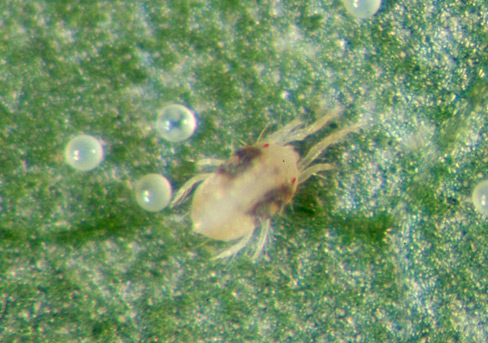Your Cart is Empty
Spider Mite Treatment
October 27, 2018 4 min read

Spider mites—sounds like the name of a kids show with cute talking insects, but for those with a hydroponic or indoor garden, those two words are real nightmare.
These tiny little pests (smaller than a size of a full stop) live in colonies on the underside of leafy greens. There’s a wide range of host plants they can choose from, like strawberries, melons, tomatoes, or eggplant—and any other groovy greens one might grow indoors.
Like elderly retirees flocking to the beach to live out their golden years playing golf, eating early-bird dinners and sun baking on the beach, spider mites are not adverse to the heat. In fact, they love it, especially dry heat, because it kills off all their predators.
Spider Mite Life cycles
Spider Mite Life cycles
In early spring, they hatch, feed, and then enter the nymphal stage, and then after molting two times they become adults.
Then, they get right to mating, and boy does that mating pay off with a lot of eggs.
Over the course of a few weeks, females will produces around 300 eggs, which rapidly develop due to the wonderful incubator of dry heat.
The whole growth process lasts about five days, so there could be several generations of spider mites overlapping at once.

Two Spotted Spider Mite With Eggs

Spider Mite Infestation
The Feast of Damage
The Feast of Damage
Spider mites feed off material in the plant cells, especially in the leaves, sort of like biting into a gusher and sucking out all the juice.
The unfortunate result of this feast is that the greenery of your plants is punctured with thousands of tiny holes, causing them to lose moisture and dry out, and totally destroying the leaves—and that can be especially annoying if you’re growing a plant purely for the leaves.
How Spider Mites Enter A Grow Room
How Spider Mites Enter A Grow Room
So when it comes to answering the question of how the mites got into the grow room, there could a number of answers. By vistors in your home, animals or any pets you have running around, and most commonly - yourself. Also if anyone has ever given you a houseplant as a gift, they may have brought some unwanted visitors over as well. At that point, the little mites in the Trojan Horse of that gifted orchid could have been dormant, so you didn’t see them. The plant could have been thriving and healthy, and you wouldn’t know, because they hadn’t hatched yet.

Keep your grow clean - don't let pests and other people inside.

Spray crop and pick off any extremely contaminated leaves. Do the best you can until harvest.

After harvest, you'll need to clean the entire room and equipment to kill all eggs and remaining mites. Then start fresh..
Spider Mites Are Wind Surfers
Spider Mites Are Wind Surfers
Spider mites are windsurfers, which sounds pretty awesome until you realize your not watching the X-games...you’re trying to grow some plants. They ride the wind on their little webs, sort of like Aladdin on a magic carpet, until they land right where you don’t want them.
Who knows? Maybe they rode in on a breeze through an open door. Or maybe they landed on you, and then you brought them in the greenhouse. You never know. But once they’re in, they’re almost impossible to get rid of..
Spider Mite Treatments
Spider Mite Treatments
So what can you do to remove spider mites from your garden?
- One of the first things you’ll want to do is prune away any infested areas that are beyond redemption.
- Dust on your plants can also foster mite growth, so consider giving your plant friends a shower.
-
Of course, you’ll also want to make sure your plants are adequately watered, because stressed-out plants are more susceptible to mite invasions.
Finally treat your plants with either Terminator, Kill-a-mite or Mite Rid - all are very effective in removing spider mites from the garden.
Do you believe in magic?
The Ozi Magic Terminata Spray is an organic and non-toxic solution that’s safe for plants, humans, and pets—but not spider mites. You can use it daily, but you will have to use it at least three times a week, even from the seedling and cutting stages, all the way through to the last two weeks of flowering. It requires some dedication, but the Grim Reaper on the bottle promises they won’t be back—and I’ve always trusted that cloaked faces of death bearing a scythe are serious about what they say.
Search and destroy
Search and destroy
Are you growing fruit trees (like pears, apples, or citrus) or vined fruits like (tomatoes and strawberries) or other plants like hops or ornamental flowers? Kill-a-Mite is a concentrated solution specifically geared towards dealing with two-spotted and red spider mites. The 100 mL bottle will make 100 litres of spray, which you can apply once to deal with the eggs, followed seven days later by second spray to make sure any surviving hatchlings are eliminated
And ya’ll don’tcome back now, hear?
And ya’ll don’tcome back now, hear?
For those looking for the most au-natural solution, Mite-Rid could do the trick. It’s made from botanical oils culled from neem, garlic, and eucalyptus...with that list of ingredients, it sounds like an enchanting perfume you might wear while hunting for vampires, or perhaps a light vinaigrette for salad (don’t try it).
Mite-Rid forms barrier on the leaves that inhibits mite-sized munching and creates a long-term solution beyond just eliminating the pests and their eggs. Even better, some of the Mite-Rid compound is absorbed by the plant and assists in inhibiting the spider mite reproductive cycle. A spray every few weeks can be a solid preventive measure for protecting your plants.
Leave a comment
Comments will be approved before showing up.




